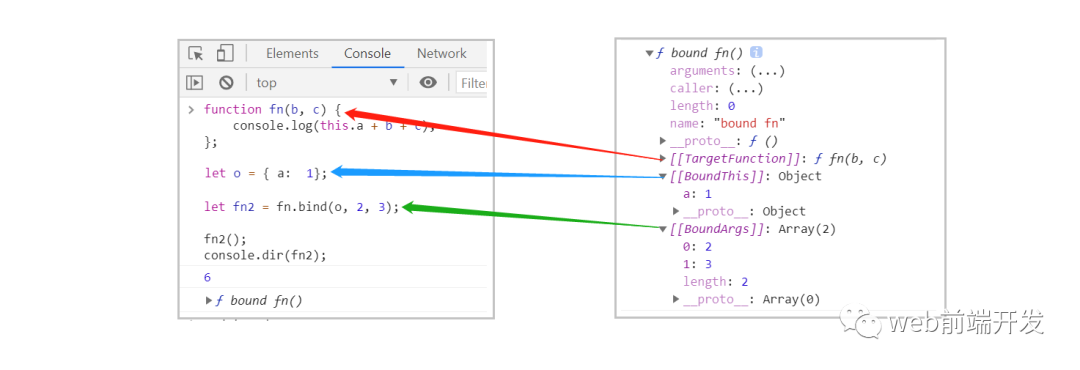一文搞懂 this、apply、call、bind

来源 | https://www.cnblogs.com/echoyya/p/14506269.html
// e.g.1var test = {a: 5,b: 6,sum: function (a, b) {function getA(a) {this.a = a; // 在window上增加了一个全局变量areturn this.a; // 此处this = window}function getB(b) {this.b = b; //在window上增加了一个全局变量breturn this.b; // 此处this = window}return getA(a) + getB(b);}}console.log(test.sum(4, 3)); // 7console.log(a); // 4 (打印结果为 window.a)console.log(b); // 3 (打印结果为 window.b)
// e.g.2var user = {name: 'Echoyya',age: 27,greet() {console.log(this.name)},bf: {name: 'KK.unlock',greet() {console.log(this.name)}}}user.greet() // Echoyyauser.bf.greet() // KK.unlock
如果 greet 函数不是 user 对象的函数,只是一个独立的函数。
function greet () {console.log(this.name)}var user = { name: 'Echoyya' }
如何能让 greet 方法调用的时候将 this 指向 user 对象?不能再像之前使用 user.greet(),因为 user 并没有 greet 方法。
我们可以通过一些方法去改变this的指向
怎样改变 this 的指向
(1)使用ES6中箭头函数
箭头函数中的 this 始终指向函数定义时的 this,而非执行时。箭头函数中没有 this 绑定,必须通过查找作用域链来决定其值,如果箭头函数被非箭头函数包含,则 this 绑定的是最近一层非箭头函数的 this,否则,this 为 undefined”。
也正因如此,箭头函数不能用于构造函数
var name = "windowsName";var obj = {name: "Echoyya",func1: function () {console.log(this.name)},func2: () => {console.log(this.name)}};obj.func1() // Echoyyaobj.func2() // windowsName
(2)函数内部使用 _this = this
如果不使用 ES6,那么这种方式应该是最简单且不易出错的方式了,先将调用这个函数的对象保存在变量 _this 中,然后在函数中都使用这个 _this。
obj调用func时 this 指向obj,防止setTimeout 被 window 调用,导致 setTimeout 中的 this 指向 window,设置 var _this = this,将 this(指向变量 obj) 赋值给一个变量 _this,这样,在 func 中使用_this 就指向对象 obj
var name = "windowsName";var obj = {name: "Echoyya",func: function () {var _this = this;setTimeout(function () {console.log(_this.name)}, 1000);}};obj.func() // Echoyya
(3)使用call,apply,bind方法
call、apply、bind 方法是每个函数都有的一个方法,允许在调用函数时为函数指定上下文。可以改变 this 指向
call 与 apply
call 方法,第一个参数会作为函数被调用时的上下文。即this 指向传给 call 的第一个参数。
传递参数给使用 .call 调用的函数时,需要在指定上下文(第一个参数)后一个一个地传入。
语法:fun.call(thisArg [, arg1[, arg2[, ...]]])
站在函数应用的角度我们知道了call与apply的用途,那这两个方法又有什么区别呢,其实区别就一点,参数传递方式不同。
call方法中接受的是一个参数列表,第一个参数指向this,其余的参数在函数执行时都会作为函数形参传入函数。
语法:fn.call(this, arg1, arg2, ...);
而apply不同的地方是,除了第一个参数作为this指向外,其它参数都被包裹在一个数组中,在函数执行时同样会作为形参传入。
语法:fn.apply(this, [arg1, arg2, ...]);
除此之外,两个方法的效果完全相同:
var o = {a: 1};function fn(b, c) {console.log(this.a + b + c);};fn.call(o, 2, 3); // 6fn.apply(o, [2, 3]); //6
关于 bind
bind要单独说一下,因为它与call,apply还不太一样。call与apply在改变this的同时,就立刻执行,而bind绑定this后并不会立马执行,而是返回一个新的绑定函数,需要在执行一下。
var o = {a: 1};function fn(b, c) {console.log(this.a + b + c);};var fn2 = fn.bind(o, 2, 3);fn2(); //6
var name = 'windowsName'function greet () {console.log(this.name)}var user = { name: 'Echoyya' }greet() // windowsNamegreet.bind()() // windowsName (非严格模式下,默认指向window)greet.bind(user)() // Echoyya
var obj = {name: "Echoyya",func: function () {setTimeout(function () {console.log(this.name)}.bind(obj)(), 100);}};obj.func() // Echoyya
call、apply、bind 区别
call、apply、bind 都是可以改变 this 的指向的,但是这三个函数稍有不同。
var test = {a: 5,b: 6,sum: function (a, b) {var self = this;function getA() {return self.a;}function getB() {return self.b;}console.log(a, b); // call, apply, bind 传入参数return getA() + getB();}}var obj = {a: 2,b: 3};console.log(test.sum.call(obj, 4, 5)); // 4,5,5 (self = this = obj)console.log(test.sum.apply(obj, [6, 7])); // 6,7,5 (self = this = obj)console.log(test.sum.bind(obj, 8, 9)()); // 8,9,5 (self = this = obj)
apply 和 call 的区别
.apply 和 .call 本质相同,他们的区别只是传入的参数不同。
传递参数给使用 .call 调用的函数时,需要在指定上下文(第一个参数)后一个一个地传入(参数列表)。
传递参数给使用 .apply 调用的函数时,可以用数组传参而且 .apply 会在函数中自动展开(参数数组)。
call、apply、bind到底有什么区别?bind返回的方法还能修改this指向吗?
apply与call是函数应用,指定this的同时也将方法执行,bind不同,它只是负责绑定this并返回一个新方法,不会执行。
尝试打印返回的新函数fn2,可以看到它并不是一个普通的function,而是一个bound function,简称绑定函数:
TargetFunction 指向 bind 前的函数;
BoundThis 是绑定的 this 指向;
BoundArgs 是传入的其它参数了。
当我们执行fn2时,有点类似于TargetFunction.apply(BoundThis,BoundArgs)。可以得出一个结论,当执行绑定函数时,this指向与形参在bind方法执行时已经确定了,无法改变。
bind多次后执行,函数this还是指向第一次bind的对象。

var o1 = { a: 1 };var o2 = { a: 2 };function fn(b, c) {console.log(this.a + b + c);};var fn1 = fn.bind(o1, 2, 3);//尝试再次传入形参fn1(4, 4); //6//尝试改变thisfn1.call(o2); //6//尝试再次bindfn1.bind(o2, 1, 1)() // 6
其实很好理解,当执行fn1时,本质上等于window.fn1(),如果this还能被改变,那this岂不是得指向window,那bind方法就没太大意义了。
学习更多技能
请点击下方公众号
![]()

